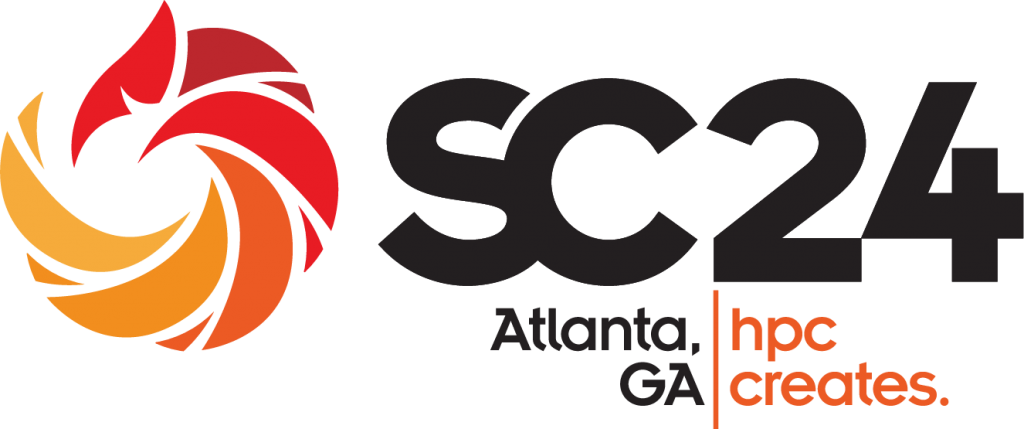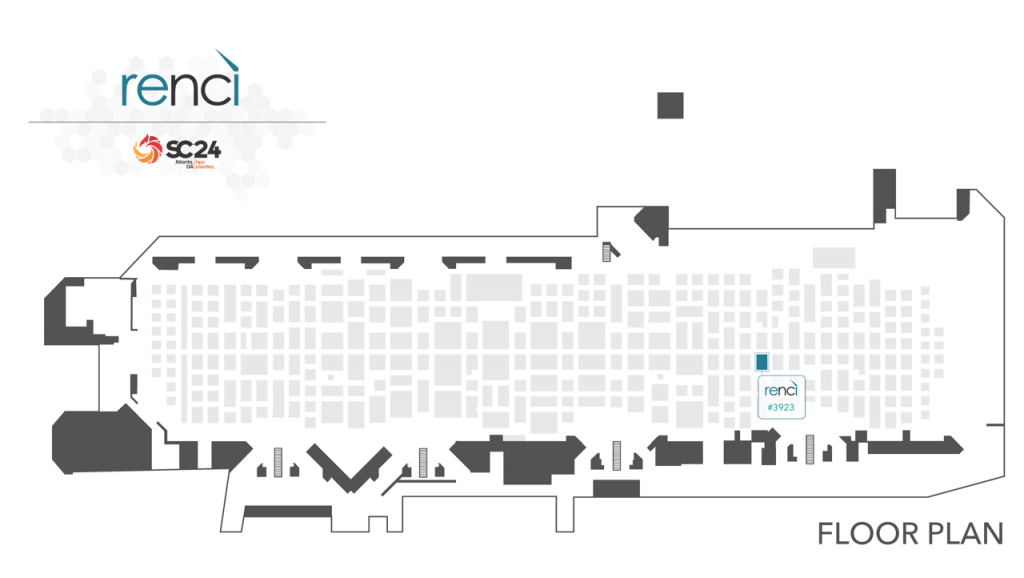
Each year, the Supercomputing conference provides the leading technical program for professionals and students in the HPC community, as measured by impact, at the highest academic and professional standards. The program is designed to share best practices in areas such as: algorithms; applications; architectures and networks; clouds and distributed computing; data analytics, visualization, and storage; machine learning and HPC; performance; programming systems; system software; and state of the practice in large-scale deployment and integration.
Visit RENCI at Booth #3923 at SC24 to learn about our collaborative research projects and cyberinfrastructure efforts aimed at helping people use data to drive discoveries.
- The Network Research and Infrastructure Group focuses on developing new types of cyberinfrastructure for domain sciences. NSF-funded projects from this team include CI Compass, PosEiDon, SWARM, AtlanticWave-SDX and FABRIC.
- The iRODS Consortium brings together businesses, research organizations, universities and government agencies to ensure the sustainability of iRODS, an open-source data management software that is continually being developed out of our institute.
- RENCI researchers help build data ecosystems and platforms for NIH-funded projects such as BioData Catalyst, HEAL, and Translator. Additionally, they develop new data science tools and methods, such as HeLx and ADCIRC.
- RENCI staff support multiple national data science community initiatives, such as the South Big Data Hub and the National Consortium for Data Science (NCDS).
Activities outside of the booth are listed on our blog. A full schedule of sessions featuring our researchers at our booth can be found at the bottom of this page. All times are in ET.
Look for updates about our activities at SC24 on social media!

11:00 – 11:15
iRODS HTTP API and OpenID Connect
Terrell Russell (iRODS)
The new iRODS HTTP API was introduced last year to increase developer accessibility to an iRODS namespace and to provide OpenID Connect access to iRODS. This talk will discuss the first five releases and ongoing work towards 1.0.
11:30 – 12:00
AtlanticWave SDX 2.0: Dynamic Cross-Domain Network Orchestration and User-Friendly Provisioning for Major Facilities and R&E Networks
Julio Ibarra (Florida International University (FIU), Division of Info. Technology)
The Atlantic Wave Software Defined Exchange SDX 2.0 project, NSF award #OAC-2029278, introduces a powerful platform for dynamic, policy-driven, cross-domain network orchestration and service provisioning across research and education networks. The presentation will focus on the SDX Controller, which is the central point of the AW-SDX system, coordinating with the Local Controllers (LC), the Data Model, the Path Computation Engine (PCE), and domain managers such as Kytos and OESS. The SDX Controller’s tasks include
- Collecting domain topology from all Local Controllers
- Assembling a global network topology
- Handling user end-to-end connection requests
- Computing optimal paths via the Path Computation Engine (PCE)
- Distribute connection requests to the appropriate local controller
We will show the implementation of user interface integration with MEICAN and The SDXLib on Jupiter Notebook, our user-friendly configuration interfaces that provide an intuitive way to manage and monitor network services.
1:30 – 1:45
iRODS S3 API
Alan King (iRODS)
The new iRODS S3 API presents iRODS via the S3 protocol. This talk will share details about the first three releases, application architecture and configuration, and the recent improvements in Multipart uploads.
2:00 – 2:45
SWARM: Scientific Workflow Applications on Resilient Metasystem
Ewa Deelman (USC Information Sciences Institute)
Current (centralized) resource management strategies typically require a global view of distributed HPC systems, relying on a cluster-wide resource manager for scheduling, with static, expert-tuned rules. This centralized decision making approach suffers from resilience, efficiency and scalability issues. In this presentation, we will describe our initial progress in the DOE SWARM project that takes a novel decentralized multi-agent approach leveraging Swarm Intelligence (SI) and consensus strategies for enhanced robustness, resilience, and fault tolerance. We will present our foundational SWARM system model to improve network overlays, enhance job selection using multi-agent consensus algorithms, and design SI-inspired scheduling approaches.In this presentation we will discuss how Project Eureka will provide a way to seamlessly integrate iRODS data-management, interactive applications, and HPAI computing. This presentation focuses on the design and architecture of Project Eureka including core components such as the OmniScheduler iRODS integration and its design to handle capabilities such as data/results staging, dynamic scratch, data publishing with job directives. Additionally the extension of Open OnDemand to include a project based user interface that supports project level organization and self service capabilities providing a ‘Collaborate First’ ethos. The design also includes standard configurations that will be provided by the UI for additional data management capabilities such as replication, archiving, ingestion, tiering, and publishing.
3:00 – 4:00
NSF CI Compass Cyberinfrastructure Center of Excellence – Recent Updates
Anirban Mandal (RENCI)
We will present an overview of the CI Compass project – an NSF Cyberinfrastructure (CI) Center of Excellence, which provides expertise and active support to CI practitioners at NSF Major and Mid-scale Facilities in order to accelerate the data lifecycle and ensure the integrity and effectiveness of the CI upon which research and discovery depend. This presentation will provide an overview of CI Compass activities – engagements, topical working groups, community building, student program, and dissemination of best practices.
10:00 – 10:15
AI in Healthcare with DDN: Improving Patient Predictive Analytics with AI
Joseph George (DDN, Global Vice President – AI Field CTO & Strategic Alliances)
Healthcare institutions work hard to accurately predicting patient outcomes, managing chronic diseases, and preventing hospital readmissions. But current patient data is often fragmented, making it difficult to extract actionable insights for predictive analytics, which lead to increased patient risks and higher healthcare costs. Join us as we discuss how an AI-based solution, from infrastructure to the application layer, leads to better real-time insights, less subjectivity and error, and better scale for patients.
11:00 – 11:15
iRODS S3 API
Alan King (iRODS)
The new iRODS S3 API presents iRODS via the S3 protocol. This talk will share details about the first three releases, application architecture and configuration, and the recent improvements in Multipart uploads.
11:30 – 1:05
FABRIC Research Infrastructure: Current Capabilities and Stories from our Users
Paul Ruth (RENCI)
This presentation will show provide an update about FABRIC testbed. The highlight of the presentation will be several FABRIC users sharing there research, techniques for using FABRIC, and scientific outcomes.
FABRIC User Presentation 1:
Title: Using AI/ML with P4 on Baric for intelligent routing
Presenter: Mariam Kiran
Abstract: In this demo, we have extended the AI tool Hecate to use P4 devices but the challenge was to see how AI/ML can be interlinked with routing decisions. Additionally, we extended the FABRIC tutorial on P4 and added new rules to allow ML to redirect flow based on real time data. This work is collaboration with Caltech and ORNL.
FABRIC User Presentation 2:
Title: Using CREASE Tooling to smoothen your Testbed Experiment experience
Presenter: Nik Sultana
Abstract: The CREASE project (“Causal REasoning and Attestation for Scientific Experimentation”) develops tooling to improve the debuggability, diagnosticability and reproducibility of programmable network experiments on research testbeds. The project has released prototype tooling that works on the FABRIC testbed. This presentation gives a mini-tutorial on using these tools and discusses the project’s plans for upcoming releases.
FABRIC User Presentation 3:
Title: FABRIC And Data Intensive Science Prototype Services
Presenter: Joe Mambretti, International Ctr for Advanced Internet Research, Northwestern U., StarLight International/National Communications Exchange Facility
Abstract: This presentation will provide an overview of how FABRIC is being used to support the multi-organizational development of prototype 1.2 Tbps/800 Gbps/400 Gbps WAN services for data intensive global science research, including services for such instruments as the Large Hadron Collider, the Square Kilometer Array, the Deep Underground Neutrino Experiment, and the Advanced Photon Source. These capabilities are being demonstrated at SC24 through the Network Research Exhibition program.
3:00 – 3:15
Towards iRODS 5.0
Kory Draughn (iRODS)
This talk will cover the current progress towards a 5.0 iRODS server release. The work shown represents more than 10 years of considered planning, communication with an open source community, and patience.
3:30 – 4:00
Transforming Unstructured Data into Actionable Insights
David Cerf (Chief Data Evangelist, GRAU DATA)
The presentation will cover how MetadataHub (MdH) enhances data management in iRODS environments by capturing and organizing comprehensive metadata from unstructured data, creating a searchable and AI-ready metadata repository with content and context from files. We’ll explore how MdH seamlessly provisions data pipelines and automates workflows, reducing IT loads and improving efficiency for research, AI, and data-driven applications.
10:30 – 10:45
Towards iRODS 5.0
Kory Draughn (iRODS)
This talk will cover the current progress towards a 5.0 iRODS server release. The work shown represents more than 10 years of considered planning, communication with an open source community, and patience.
12:00 – 12:15
iRODS HTTP API and OpenID Connect
Terrell Russell (iRODS)
The new iRODS HTTP API was introduced last year to increase developer accessibility to an iRODS namespace and to provide OpenID Connect access to iRODS. This talk will discuss the first five releases and ongoing work towards 1.0.
1:00 – 1:45
FABRIC Research Infrastructure: Current Capabilities and Stories from our Users
Paul Ruth (RENCI)
This presentation will show provide an update about FABRIC testbed. The highlight of the presentation will be several FABRIC users sharing there research, techniques for using FABRIC, and scientific outcomes.
FABRIC User Presentation 1:
Title: Multi-Domain Experiments Using ESnet SENSE on the National Research Platform / PacWave / FABRIC
Presenter: Mohammad Firas Sada
Abstract: The SC24 Network Research Exhibition (NRE) will demonstrate the use of ESnet SENSE for orchestrating edge-programmable segment routing applications across FABRIC and NRP (Nautilus). These demonstrations utilize Xilinx U280 FPGAs at FABRIC testbed sites, U55C FPGAs within the Nautilus Kubernetes cluster, and SN1000/SN1022 SmartNICs deployed on Nautilus and in the FABRIC mobile CIENA site. The experiments implement segment routing over IPv6 (SRv6) with microSID (uSID) functionality, enabling orchestration of network paths and data flows across multi-domain environments and illustrating interoperability between programmable infrastructure on FABRIC and NRP.
FABRIC User Presentation 2:
Title: Traffic Steering Without the Switch: Offloading Big Flows to the NIC
Presenter: Justas Balcas
Abstract: Our project leverages Fabric infrastructure to offload routing by using DPDK-accelerated (VPP+FRR or FreeRTR) virtualized software routers running inside containers, enabling high-performance network guarantees for sites supporting LHC experiments like CMS and ATLAS. VPP uses DPDK to directly access the NIC, bringing packets into user space for routing decisions, while offloading only specific tasks, such as IPv4, UDP, and TCP checksum calculations, to the NIC. In our setup, we deploy VPP+FRR, which bypasses the Linux kernel and allows VPP to operate fully in user space; FRR functions as a routing daemon to update kernel routes, with routes synced to VPP through API calls, enabling the CPU within VPP to handle packet forwarding and routing logic. By integrating this with SENSE (SDN for End-to-End Networked Science at the Exascale), we provide the necessary mechanisms to dynamically establish end-to-end, guaranteed virtual networks across multiple NRENs and sites.




